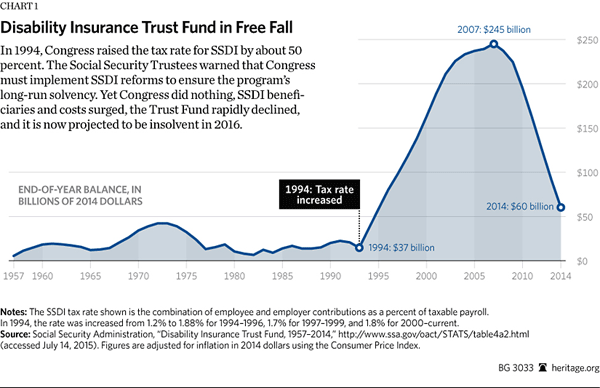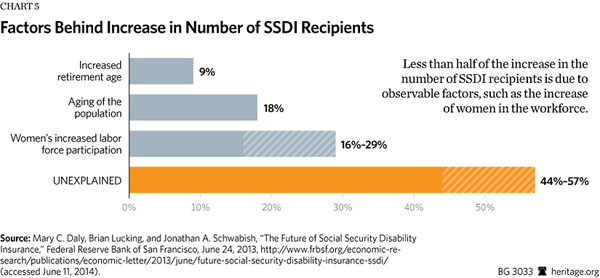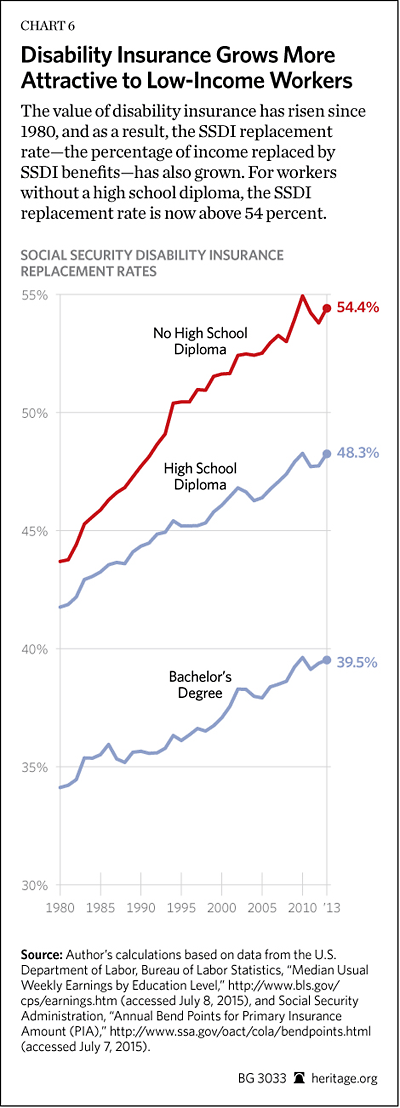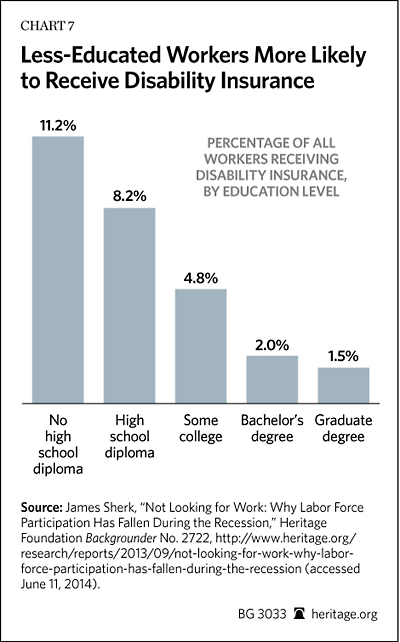According to the 2015 Social Security Trustees Report, the Social Security Disability Insurance (SSDI) Trust Fund is on course to run dry in 2016, six decades after the program began in 1956.[1] Absent reform, disability benefits will be cut across the board by almost 20 percent, and the average disabled worker’s benefit will fall below the federal poverty level.
For nearly 60 years now, SSDI has provided critical income support for disabled workers and their families. Over time, however, the program has increasingly become an early retirement and long-term unemployment program serving not only the disabled who truly cannot work, but also the marginally disabled who, while having a harder time working, are able to hold down certain jobs or work part time. Furthermore, the program is impaired by outright fraud and abuse. Such misuses and abuses undermine the integrity and financial stability of disability insurance.
Millions of truly disabled Americans and their families rely on SSDI benefits as their primary source of income. A 20 percent cut in benefits would be devastating to individuals who are not able to work, and have little or no outside income. While it is too late to implement reforms that would prevent the Trust Fund from running dry in the near term, Congress should limit financial relief to borrowing that is conditioned on reforms that will preserve the long-run solvency of the disability Trust Fund. Social Security’s Old-Age and Survivors Insurance (OASI) program should not be drawn upon as a backstop to SSDI.
Status of the SSDI Trust Fund
SSDI registered its sixth straight deficit in 2014 as the Trust Fund declined by $30.2 billion, from $90.4 billion in 2013 to $60.2 billion. Each dollar in benefits was met with only 77 cents in payroll tax contributions.
Although 2014 marks the sixth year of net deficits for the Trust Fund, the program has been running cash-flow deficits for 10 years, bringing in less tax revenue than it pays out in benefits. This has been possible because the program has been cashing in on interest payments that are due to be paid to the Trust Fund as a result of previous borrowing. However, since those interest payments come out of general revenues, they add to the federal deficit. Over the past decade, SSDI cash flow deficits have added $213 billion to federal deficits.
Over the next 10 years, SSDI faces a $256 billion shortfall, according to the Social Security trustees’ intermediate projections. Keeping the Trust Fund solvent over the next 75 years would require an immediate cut in benefits of nearly 20 percent, or a 17 percent increase in the SSDI payroll tax rate. If growth in the program exceeds the trustees’ projections, as it has in the past, these estimates may understate the true shortfall.
The little revenue that remains in the SSDI Trust Fund (as a result of interest payments paid to the Trust Fund based on previous borrowing) is quickly diminishing. Absent reforms, the Trust Fund will run dry by the end of 2016, and incoming payroll taxes will be sufficient to cover only 81 percent of SSDI benefits. Across-the-board benefit cuts would reduce the average disabled worker benefit from $1,165 to $944, bringing it below the federal poverty level ($981 for a single person in 2015).
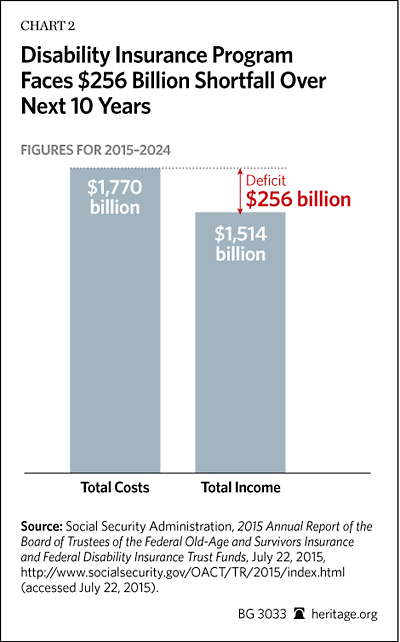
Growth of the Disability Insurance Program
Workers are healthier today, people are living longer, and jobs are less physically demanding.[2] So why has the percentage of the working-age population (ages 16 to 64) who receive SSDI benefits more than doubled from 2.3 percent in 1990 to 5.1 percent in 2014?[3] A good portion of the growth has to do with demographic factors, such as the aging of the baby boomers, women’s increased labor force participation (and SSDI eligibility), and the increase in Social Security’s standard retirement age.
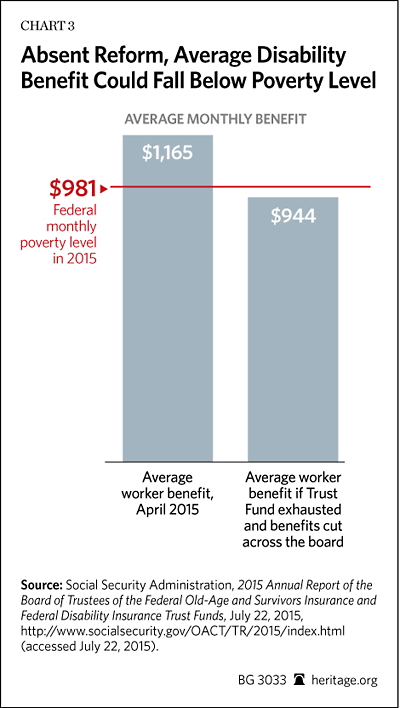
Even after accounting for these factors, a study by the Federal Reserve Bank of San Francisco found that roughly half of the increase in SSDI beneficiaries since 1980 remains unexplained.[4] This unexplained growth—roughly 3 million SSDI beneficiaries ($42 billion in benefits each year)—is likely the result of greater accessibility to benefits and a higher relative value of benefits.[5]
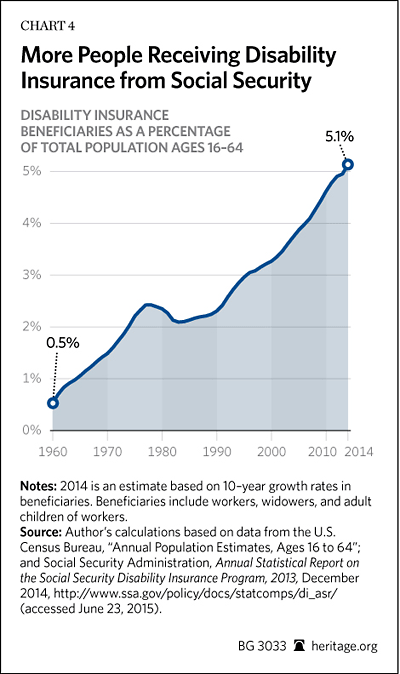
Greater access to SSDI benefits began in 1978 when Congress added non-medical, vocational factors (so-called grid factors), such as age, education, and ability to speak English, to the list of SSDI qualifications. Today, about 43 percent of all SSDI awards are based on these vocational grid factors.[6] With these new qualifying criteria (that is, more ways to be designated as disabled) came rising SSDI claims and costs in the 1980s. In response, Congress initially tightened SSDI-qualification standards, but then, amidst a public backlash, Congress reversed course and further liberalized them. Consequently, a higher portion of SSDI claims are the result of more subjective, difficult-to-verify claims, such as depression and musculoskeletal pain. Vastly different approval rates across different hearing levels and judges attests to the problem of subjective measures of disability; some truly disabled applicants are denied benefits, while some able-bodied individuals receive them.
Higher benefit values stem from the fact that rapid income growth at the top has driven up the index used to calculate SSDI benefits. From 1980 to 2013, the real average wage used to calculate SSDI benefits increased by 29 percent, while median usual weekly earnings of workers with less than a high school degree fell by 23 percent.[7] This translates into higher replacement rates (the percentage of income replaced by SSDI benefits) for lower-wage workers. From 1980 to 2013, SSDI’s replacement rate for workers without a high school degree increased from 43.7 percent to 54.4 percent.[8] Higher replacement rates have made SSDI more attractive over time. A Heritage Foundation study showed that more than 11 percent of typically low-wage workers (those with less than a high school degree) receive SSDI benefits, compared with less than 2 percent of higher-wage workers (those with a college or graduate degree).[9]
SSDI Is Broken
SSDI was enacted as a safety net for people who became permanently disabled after having had a work history. As evidenced by the growth in SSDI rolls, from less than 0.5 percent of the working-age population in 1960 to more than 5 percent today, SSDI has expanded far beyond its original intent and now faces imminent insolvency.[10]
Marc Goldwein of the nonpartisan Center for a Responsible Federal Budget aptly sums up the problems of the SSDI program:
Not only is the program financial[ly] insolvent, but the system is wrought with fraud, needlessly complex, difficult to navigate, inconsistent and unfair in determining eligibility, inflexible to changes in the structure of the workforce, administratively overburdened, almost completely uncoordinated with other government policies, and unable to help or reward those who are interested in reentering the workforce.[11]
Simply pumping more money into a broken system is the wrong approach. Allowing the SSDI program to continue unchecked not only harms taxpayers who finance the program, it is also a disservice to truly disabled individuals who are often stigmatized as a result of fraud and abuse in SSDI that goes largely unchecked.
Reallocation Is Robbery
The President and some policymakers want to “reallocate” a portion of taxes devoted to the OASI Trust Fund to the SSDI Trust Fund. OASI and SSDI are two distinct programs, with separate purposes, separate payroll taxes, and legally separate trust funds. A payroll tax reallocation would rob OASI of about $330 billion in tax revenues and force the program into even earlier insolvency. It could also set the stage for Medicare’s Hospital Insurance (HI) program to similarly tap the OASI Trust Fund, as the Trustees currently project that the HI Trust Fund will become insolvent in 2030, four years before the OASI Trust Fund runs dry. The fact that the OASI Trust Fund will be the last man standing should not mean that it has to bail out other insolvent programs. This type of race-to-the-bottom approach would encourage moral hazard and delay or prevent necessary entitlement reforms.
Additionally, reallocating money from the OASI Trust Fund to the SSDI program would increase near-term budget deficits. Despite the existence of a $2.8 trillion Trust Fund, the OASI program has been running cash-flow deficits since 2010. Thus, financing the SSDI deficit with paper IOUs from the OASI Trust Fund would increase near-term budget deficits on a dollar-for-dollar basis, and each of those dollars would need to be borrowed from the public, raising the public debt even higher.
It Is Not Too Late for Reform
With less than a year and a half before the SSDI Trust Fund runs dry, it is too late to enact and implement reforms that will make the SSDI Trust Fund solvent by 2016—but that does not mean that it is too late to enact reforms that will make the SSDI program solvent over the long term. The SSDI program is ripe for reform, and many scholars and organizations, such as the McCrery Pomeroy SSDI Solutions Initiative, are actively engaged in thoughtful research and advocacy of measures to improve the effectiveness, integrity, and financial stability of the SSDI program.[12]
A multitude of problems and inefficiencies plague SSDI. Multiple reforms will be necessary to improve its efficiency, integrity, and financial stability. Some promising reforms are:
- Providing incentives and support to help disabled individuals return to work;
- Establishing needs-based disability periods;
- Offering optional private disability insurance as part of the public program;
- Modernizing the disability definitions and qualifications;
- Implementing more effective and regular continuing disability reviews;
- Applying a flat benefit structure; and
- Improving the efficiency and integrity of the adjudication process.
Regardless of which reforms policymakers ultimately enact, it would be reckless to allow the SSDI program to take or borrow money from the OASI Trust Fund without requiring reforms that increase SSDI’s solvency. Just as federal lending standards prevent individuals and businesses from obtaining loans that they will never be able to repay, the SSDI program should not receive any additional funding until it has established a credible plan for long-term solvency. The time for establishing that plan is now.
—Rachel Greszler is Senior Policy Analyst in Economics and Entitlements in the Center for Data Analysis, of the Institute for Economic Freedom and Opportunity, at The Heritage Foundation.
